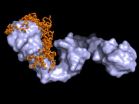(Press-News.org) An international team of researchers has used the world's most powerful X-ray laser to take snapshots of free molecules. The research team headed by Prof. Jochen Küpper of the Hamburg Center for Free-Electron Laser Science (CFEL) choreographed a kind of molecular ballet in the X-ray beam. With this work, the researchers have cleared important hurdles on the way to X-ray images of individual molecules, as they explain in the scientific journal Physical Review Letters. CFEL is a cooperation of DESY, the University of Hamburg, and the Max Planck Society.
"We have captured the first images of an ensemble of isolated molecules with an X-ray laser," said DESY scientist Küpper, who is also a professor at the University of Hamburg and a member of the Hamburg Centre for Ultrafast Imaging (CUI) cluster of excellence. "The molecules all posed for the picture in synch." According to Küpper, this approach opens the way for studies of the ultra-fast dynamics of isolated molecules. There are existing techniques to image single molecules, but none of these is fast enough to catch the ultra-fast motion of molecules.
The conventional way to determine the atomic structure of molecules is to "freeze" them in a crystal and illuminate them with bright X-rays. However, many molecules are extremely difficult to crystallise. In particular, this is a problem with many biomolecules. What's more, molecules in a crystal can have different properties than molecules in their free form. And molecular dynamics can only be studied to a very limited extent in the crystalline state. Yet exactly this information is in great demand in chemistry, physics, materials research and life sciences. Researchers are therefore working on methods for taking snapshots of individual free molecules.
"The molecules we are investigating are some of the smallest structures in chemistry and biology and consist of just a handful of atoms," emphasised co-author Dr. Stephan Stern of CFEL. "In order to observe them, you need the most powerful X-ray source on earth, with the shortest exposure time — one ten-trillionth of a second." The researchers therefore used what is currently the most powerful X-ray laser, the Linac Coherent Light Source (LCLS) at the SLAC National Accelerator Laboratory in California. This free electron laser (FEL) generates short-wave X-ray light by using powerful magnets to send fast electrons from a particle accelerator along a tightly defined slalom course.
In every curve, the fast particles emit flashes of light which add up to an intense laser pulse. These X-ray pulses have such a short wavelength that they can make even atomic dimensions visible. They are also so short and so bright that they can be used to freeze the ultra-fast motion of molecules. But not even this bright light is currently capable of making clear images of single molecules. That's why the researchers use a trick to study the molecules — they measure how strongly the X-ray light is scattered by the molecules. The molecular structure can be calculated from this diffraction pattern. The more molecules contribute to the diffraction pattern — for example, in a crystal — the clearer it will be.
Instead of a crystal, Küpper's team illuminated an ensemble of around 100 individual molecules for every single image. However, these molecules must all have the same orientation, so that their diffraction patterns add up and amplify one another. The team took a simple molecule — consisting of a benzene ring with a small nitrile arm of carbon and nitrogen and with two iodine atoms attached, one above and one below. The researchers first sorted the compound — known chemically as di-iodobenzonitrile — using an inhomogeneous electric field, so that only molecules in the same quantum state could wander into the X-ray beam. They then used a special arrangement of lasers to ensure that the particles all took up the same pose for the photo — like the members of a ballet ensemble — so that all of the benzene rings had the two iodine atoms aligned at their top and bottom.
"We sorted the molecules, led them onto the stage, and then got them to pose in synch for the photo," said Stern. "Then we took the picture with an ultra-short flash of incredible brightness. The exposure time was so short that the superfast motion of the molecules was frozen and we were able to capture a sharp image of the tiny structures." In this way, the researchers were able to determine that the distance between the two iodine atoms on the benzene ring was 800 picometres (800 billionths of a millimetre), which is in good agreement with the actual value of 700 picometres known from theory.
The experiments thus point the way to the investigation of extremely high-speed molecular dynamics, in particular at the European X-Ray Laser XFEL, which is currently being constructed from the DESY site in Hamburg's Bahrenfeld district to the neighbouring town of Schenefeld in Schleswig-Holstein. "In future, we will be able to get the molecules to carry out predetermined sequences of movements, like all of them waving their arms", said Küpper. "We will be able to film these movements by repeating the experiment a large number of times, taking the snapshots at slightly different times and putting the resulting pictures together in a film. Just like a super slow-motion shot in a sports event or a documentary, these films will show the exact sequence of movements of the molecules during chemical reactions with a precision and level of detail that have never before been achieved."
Researchers from Germany, Denmark, the Netherlands, Sweden and the USA participated in the study.
INFORMATION:
The Linac Coherent Light Source is a Department of Energy Office of Science-funded facility located at SLAC National Accelerator Laboratory. LCLS is the world's first hard X-ray free-electron laser, allowing researchers to see atomic-scale detail on ultrafast timescales. The LCLS enables groundbreaking research in physics, chemistry, structural biology, energy science and many other diverse fields.
Deutsches Elektronen-Synchrotron DESY is the leading German accelerator centre and one of the leading in the world. DESY is a member of the Helmholtz Association and receives its funding from the German Federal Ministry of Education and Research (BMBF) (90 percent) and the German federal states of Hamburg and Brandenburg (10 percent). At its locations in Hamburg andZeuthen near Berlin, DESY develops, builds and operates large particle accelerators, and uses them to investigate the structure of matter. DESY's combination of photon science and particle physics is unique in Europe.
Reference
"X-ray diffraction from isolated and strongly aligned gas-phase molecules with a free-electron laser"; J. Küpper, S. Stern, H. N. Chapman, et al.; Physical Review Letters, 2014; DOI: 10.1103/PhysRevLett.112.083002
A molecular ballet under the X-ray laser
Researchers capture snapshots of free molecules by the light of the free-electron laser
2014-02-28
ELSE PRESS RELEASES FROM THIS DATE:
Indonesia's competitiveness at risk from neglected diseases of poverty
2014-02-28
WASHINGTON, D.C. – February 27, 2014 – The control and elimination of neglected tropical diseases (NTDs) is one of the most cost-effective ways Indonesia can sustain economic growth and reduce inequality, said scientists today in an analysis published in PLOS Neglected Tropical Diseases. While Indonesia is poised to defeat NTDs by 2020, it has an opportunity to scale up national programs, integrate NTDs with other development efforts, strengthen coordination and enhance collaboration among key partners.
The analysis calls NTDs "one of the most potent forces" trapping ...
NASA saw rainfall rates increase before birth of Tropical Storm Faxai
2014-02-28
VIDEO:
NASA/JAXA's TRMM Satellite provided data of developing Tropical Storm Faxai to make this 3-D image that showed some towering thunderstorms in the area were reaching altitudes of up to 15.5km/~9.6...
Click here for more information.
The Tropical Rainfall Measuring Mission or TRMM satellite passed over System 93W in the Northwestern Pacific Ocean and saw rainfall rates increasing on February 27 in the developing tropical low pressure area. On February 28, the low organized ...
Peat soils as gigantic batteries
2014-02-28
This news release is available in German. Wetlands, including peatlands, have a high content of humic substances, which are organic compounds that form during incomplete decomposition of biomass. Under anoxic conditions, soil bacteria can use these organic compounds during respiration as electron acceptors. Many organisms (including us humans) instead use oxygen as the electron acceptor.
In the mid-1990s, researchers revealed that some anaerobic microorganisms in soils and sediments use humic substances as electron acceptors under anoxic conditions. However, the capacity ...
Giant sunspot makes third trip across the sun
2014-02-28
A giant sunspot – a magnetically strong and complex region on the sun's surface – has just appeared over the sun's horizon. This is the third trip for this region across the face of the sun, which takes approximately 27 days to make a complete rotation.
Scientists track sunspots that are part of active regions, which often produce large explosions on the sun such as solar flares and coronal mass ejections, or CMEs. Each time an active region appears it is assigned a number. Active regions that have survived their trip around the back of the sun and reappear are assigned ...
New fast and furious black hole found
2014-02-28
A team of Australian and American astronomers have been studying nearby galaxy M83 and have found a new superpowered small black hole, named MQ1, the first object of its kind to be studied in this much detail.
Astronomers have found a few compact objects that are as powerful as MQ1, but have not been able to work out the size of the black hole contained within them until now.
The team observed the MQ1 system with multiple telescopes and discovered that it is a standard-sized small black hole, rather than a slightly bigger version that was theorised to account for all ...
Researchers discover unusual genetic mutation linked to adolescent liver cancer
2014-02-28
In the race for better treatments and possible cures, rare diseases are often left behind. In a collaboration of researchers at The Rockefeller University, Memorial Sloan Kettering Cancer Center and the New York Genome Center (NYGC), an unusual mutation has been found that is strongly linked to one such disease: a rare liver cancer that affects teens and young adults. The results, published this week in Science, suggest that the mutation plays a key role in the development of the disease, called fibrolamellar hepatocellular carcinoma, and may also underlie more common cancers ...
Retention leads to discipline problems in other kids
2014-02-28
DURHAM, N.C -- When students repeat a grade, it can spell trouble for their classmates, according to a new Duke University-led study of nearly 80,000 middle-schoolers.
In schools with high numbers of grade repeaters , suspensions were more likely to occur across the school community. Discipline problems were also more common among other students, including substance abuse, fighting and classroom disruption.
Public debate typically focuses on how retention affects an individual student's academic performance, said lead author Clara Muschkin. So she and her colleagues ...
Dangerous mistaken identity
2014-02-28
This news release is available in German.
Proteins like the so-called heat shock protein Hsp90 play an important role in almost all processes within human cells. They help other proteins fold into their three-dimensional structure or return damaged proteins back into their proper shape.
Recently, there has been increasing evidence indicating that the heat shock protein HSP90 may also be involved in the folding processes of the tau protein. Deposits of tau proteins in brain cells are typical for Alzheimer's disease and are held responsible for decaying nerve ...
Diabetes and obesity more common in socioeconomically deprived regions
2014-02-28
Living in a socioeconomically deprived region is a risk factor for being affected by diabetes mellitus and obesity. This holds true regardless of the individual social status of the inhabitants. This is the conclusion reached by scientists from the Institute of Health Economics and Health Care Management (IGM) at the Helmholtz Zentrum München (HMGU) and the Department of Epidemiology and Health Monitoring at the Robert Koch Institute (RKI) in Berlin. "Regional factors, such as the population's average income, unemployment or quality of the living environment can affect ...
Unearthing key function of plant hormone
2014-02-28
This news release is available in German.
Plants, like animals, employ hormones as messengers, which coordinate growth and regulate how they react to the environment. One of these plant hormones, auxin, regulates nearly all aspects of plant behavior and development, for example phototropism, root growth and fruit growth. Depending on the context, auxin elicits a range of responses such as cell polarization or division. In this week's edition of Science (DOI:10.1126/science.1245125), a team of researchers including Jiri Friml from IST Austria and led by Zhenbiao ...
LAST 30 PRESS RELEASES:
Making lighter work of calculating fluid and heat flow
Normalizing blood sugar can halve heart attack risk
Lowering blood sugar cuts heart attack risk in people with prediabetes
Study links genetic variants to risk of blinding eye disease in premature infants
Non-opioid ‘pain sponge’ therapy halts cartilage degeneration and relieves chronic pain
AI can pick up cultural values by mimicking how kids learn
China’s ecological redlines offer fast track to 30 x 30 global conservation goal
Invisible indoor threats: emerging household contaminants and their growing risks to human health
Adding antibody treatment to chemo boosts outcomes for children with rare cancer
Germline pathogenic variants among women without a history of breast cancer
Tanning beds triple melanoma risk, potentially causing broad DNA damage
Unique bond identified as key to viral infection speed
Indoor tanning makes youthful skin much older on a genetic level
Mouse model sheds new light on the causes and potential solutions to human GI problems linked to muscular dystrophy
The Journal of Nuclear Medicine ahead-of-print tip sheet: December 12, 2025
Smarter tools for peering into the microscopic world
Applications open for funding to conduct research in the Kinsey Institute archives
Global measure underestimates the severity of food insecurity
Child survivors of critical illness are missing out on timely follow up care
Risk-based vs annual breast cancer screening / the WISDOM randomized clinical trial
University of Toronto launches Electric Vehicle Innovation Ontario to accelerate advanced EV technologies and build Canada’s innovation advantage
Early relapse predicts poor outcomes in aggressive blood cancer
American College of Lifestyle Medicine applauds two CMS models aligned with lifestyle medicine practice and reimbursement
Clinical trial finds cannabis use not a barrier to quitting nicotine vaping
Supplemental nutrition assistance program policies and food insecurity
Switching immune cells to “night mode” could limit damage after a heart attack, study suggests
URI-based Global RIghts Project report spotlights continued troubling trends in worldwide inhumane treatment
Neutrophils are less aggressive at night, explaining why nighttime heart attacks cause less damage than daytime events
Menopausal hormone therapy may not pose breast cancer risk for women with BRCA mutations
Mobile health tool may improve quality of life for adolescent and young adult breast cancer survivors
[Press-News.org] A molecular ballet under the X-ray laserResearchers capture snapshots of free molecules by the light of the free-electron laser






